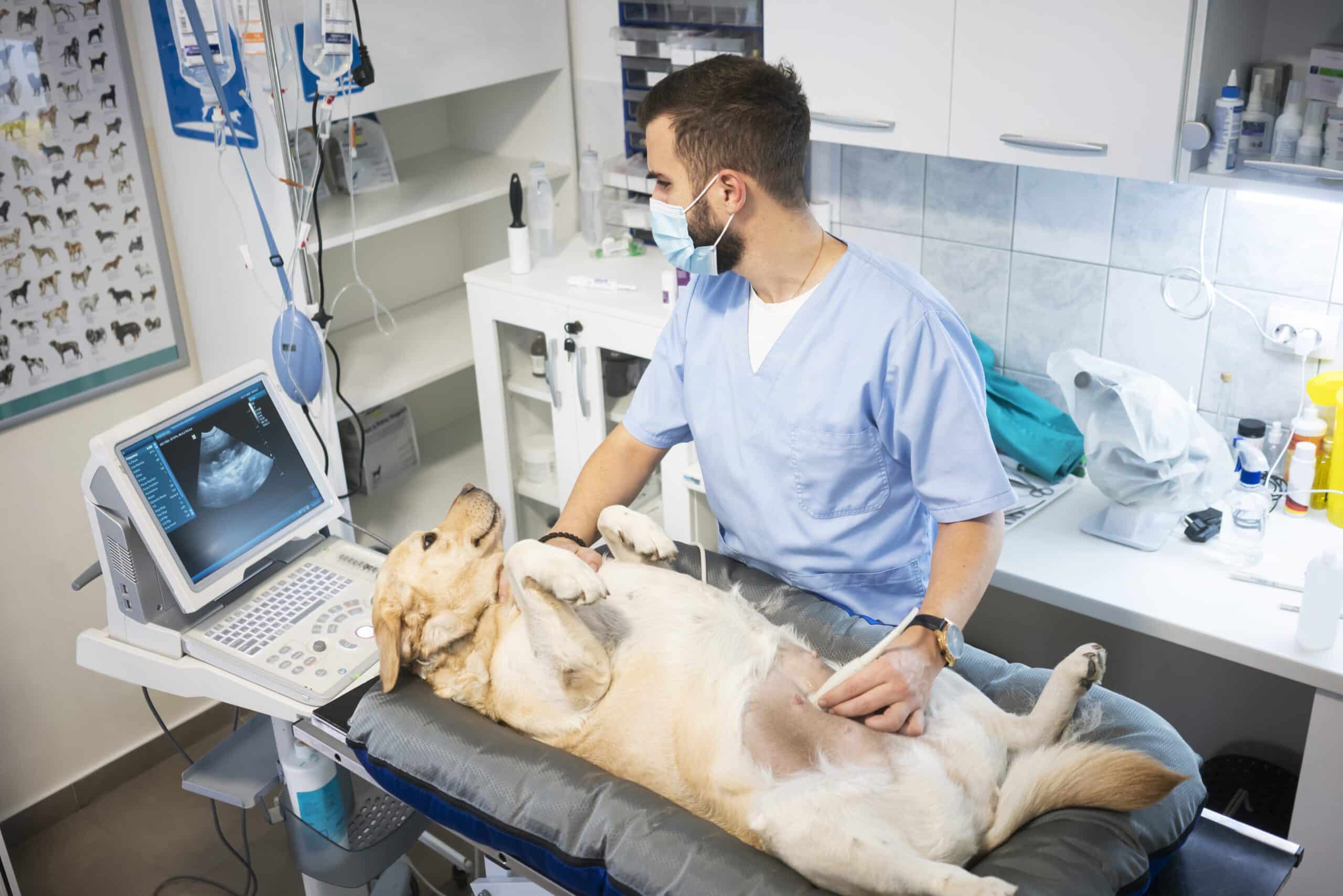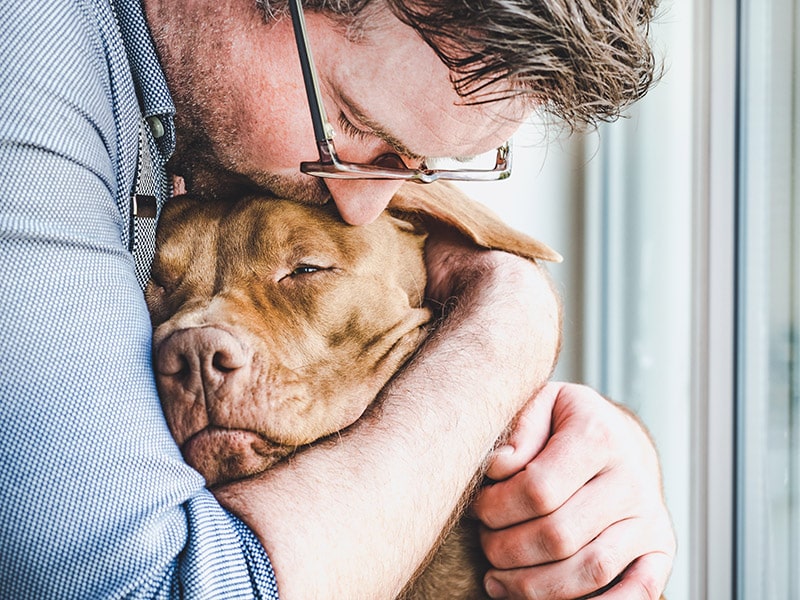In this article
Finding out your dog has cancer is devastating news for any pet owner. Deciding when it is time to say goodbye is one of the most difficult parts of the whole ordeal. It can be a huge worry if your dog has been diagnosed with cancer. It is important to remember that not all cancer diagnoses mean that your dog is going to die.
Some cancers can, however, cause dogs serious pain and suffering. If your dog is in unmanageable pain, if the side effects of their treatment are worse than the benefits, or if their quality of life has been compromised, it is time to have a frank discussion with your vet about choosing to humanely end their life by euthanizing them.
Only you can fully understand your dog’s unique situation and assess their needs and degree of suffering. Your vet can advise you on the clinical aspect of things. It is an extremely difficult decision for any owner to make, but rest assured, your vet will be with you every step of the way.

Cancer in Dogs
Cancer can affect dogs of all shapes, sizes, breeds, and ages, and it is frequently seen in older dogs. Common cancers occurring in dogs affect the skin, digestive system, and lymph nodes. There are many types of cancer. Some can be seen by owners, such as mammary gland tumors or skin cancer. Some cannot be seen, such as lung or liver cancer.
In those cases, it is the clinical signs caused by the cancer that the owners notice first.
It is important to remember that some cancers are more serious than others. Some are malignant, which means they spread across the body; others are benign, which means they stay in their primary location and do not invade other body parts.
Cancer occurs when cells inside your dog’s body start to multiply uncontrollably. Usually, this results in a tumor developing (unless the cancer is affecting the blood). Malignant tumors spread across your dog’s body and cause several problems.

Typical Signs of Cancer in Dogs
Each type of cancer will present with its own unique set of clinical signs. Some of the common signs include:
- Noticeable tumor /mass or lump
- Lethargy
- Evidence of pain
- Reduced food intake
- Drinking more
- Urinating more
- Weight loss
- Non-healing wounds
- Coughing
- Breathing difficulties
- Vomiting
- Diarrhea
- Sleeping more
As well as clinical signs, there are also behavioral signs owners might notice at home.
If you are concerned about the health and well-being of your pet, seek veterinary advice for the best course of action.
If you need to speak with a vet but can't get to one, head over to PangoVet. It's an online service where you can talk to a vet online and get the personalized advice you need for your pet — all at an affordable price!

The 8 Signs You Should Think About When Euthanizing Your Dog with Cancer
There is no right or wrong answer when it comes to deciding on the right time to euthanize your beloved dog. There are some signs you can look out for and monitor to help you and your vet make the decision:
1. Noticeable decline in Quality of Life
Our dogs must have the best quality of life possible. Sometimes, despite your and your vet’s efforts, your dog may start to suffer unduly. This can be because treatment is not working or because the cancer is out of control and is spreading rapidly.
If your dog is uncomfortable and is unable to carry out their day-to-day activities without being in pain or suffering, it is an unacceptable quality of life. Your dog should be able to enjoy normal activities, be free from pain, and eat and drink normally.

2. Losing Interest in Food
If your dog suddenly does not show interest in their food, it is usually a sign they are very sick. They may only manage small amounts or refuse to eat their regular food but eat treats if hand-fed.
Good nutrition is so important, especially if your dog is sick, so if they are not eating, they will deteriorate very quickly. Your vet can prescribe appetite stimulants; however, they do not treat the underlying cause, so they may not have any effect.
3. Breathing difficulties
If your dog is showing signs of respiratory distress, it won’t be very pleasant for them. Often, with cancers that spread to the lungs, there is a large build-up of fluid that means the lungs cannot function properly. If your dog is having trouble breathing, they will be suffering, and if the issue cannot be resolved, the kindest thing to do is to euthanize them.
4. Signs of Pain
In many cases, there are pain relief options that your vet will discuss with you. If your dog has already been given appropriate pain relief yet is still showing signs of being in pain, it is an indication it may be time to consider euthanasia.
Bear in mind that some dogs will experience pain but will not show any obvious signs. This can make it even harder to gauge when to say goodbye.

5. Behavioral Changes
If you suddenly notice your dog is extremely clingy and affectionate, or if they have become withdrawn and choose to isolate themselves, it may be a sign they are suffering. They may be distressed because they feel unwell and seek comfort, or they may hide to be alone because they are in pain.
6. Weakness and lethargy
You may notice that your dog is weak and cannot stand or walk properly. They may also have difficulty going to the bathroom. This is because they may not be able to support themselves when squatting or cocking their leg to pass urine or feces.
This can be very distressing for some dogs, especially if they soil themselves. They can also experience fecal and urine scalding, which can lead to large sores that are very painful.
7. Incontinence
For various reasons, dogs with cancer can lose control of their bladder and bowels. It can be highly distressing for dogs, especially if they have been toilet trained all their life and are used to going to the bathroom outside.

8. Type of Cancer and Prognosis
Some cancers are very aggressive and can spread very quickly. Even dramatic salvage procedures will not make much of a difference to your dog’s prognosis. Sometimes, cancers are only diagnosed when they have spread across the body and are affecting multiple organs.
Other cancers are inoperable, or the dog may not be a suitable candidate for surgery. If that is the case, often the kindest option is to euthanize your dog since whatever treatment your vet may carry out will not make a significant difference.

What Are the Signs of Suffering in Dogs?
Depending on the dog, they may show obvious signs they are suffering, or they may give no clue at all. Dogs can be very stoic, and if the cancer is not aggressive, they may have no clinical signs. The signs to look out for include:
- Unwilling to go on walks or move about the house
- Crying or whimpering
- General restlessness
- Sudden aggression towards other people or animals
- Accidents around the house when they have been toilet trained
- No appetite
- Sudden weight loss
- Unable to sleep
- Panting
- Becoming withdrawn and isolating themselves or becoming clingy
- Resenting being touched
- Obvious signs of pain, such as limping
The decision to euthanize your dog should always be made with your vet’s input. Your vet will be able to assess your dog’s circumstances and the development and prognosis of the cancer. They will also consider any other factors that will contribute to your dog’s health status (such as any concurrent diseases).
Owners can use several animal welfare organizations for guidance and reference, such as the American Veterinary Medical Association (AVMA) and the Association for Pet Loss and Bereavement (APLB). These organizations offer valuable resources and support for owners facing difficult decisions with their beloved pets.

Dealing with Grief
Regardless of how your dog passes away, whether by euthanasia or natural causes, it is always a heartbreaking experience. People experience grief in many ways. It is normal to feel despair and loneliness after losing a dog.
Some owners experience self-doubt or guilt, especially if they have decided to have their dog euthanized. It is important to seek the right support to help navigate through such a difficult time. The bond between an owner and their dog is so special, and the grief owners feel reflects that.
Some organizations can help owners deal with their feelings after losing a dog.
As mentioned above, The Association for Pet Loss and Bereavement is a nonprofit organization staffed by volunteers trained in pet bereavement counseling who can help owners. If you are struggling, do not hesitate to reach out to someone.

Conclusion
Learning to live with a dog with cancer is hard enough, and knowing when it is the right time to say goodbye is never easy. It is personal to your unique situation with your beloved dog and involves weighing several factors.
As their owner, you are the best advocate for your pet’s general well-being. Your vet can discuss the cancer diagnosis and prognosis with you, and there will be physical and behavioral signs you will experience at home that will give you an indication of when the time is right. It is a heartbreaking dilemma, and it must be an informed decision with your dog’s best interests at heart.
See also:
- Euthanized Dog Wakes Up: The Shocking Story
- My Dog Has Cancer: What Now? Treatment Options Explained (Vet Answer)
Featured Image Credit: SvetikovaV, Shutterstock


















